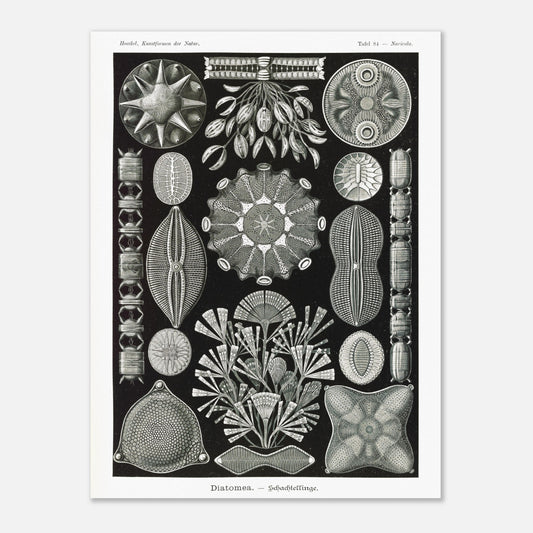Diatoms - Naturalist engraving - Ernst Haeckel, Kunstformen der Natur
Diatoms - Naturalist engraving - Ernst Haeckel, Kunstformen der Natur
Couldn't load pickup availability
Reproduction engraving of: Diatoms
Original title Diatomea - Diatoms
Poster of Navicula - Algae of the main class of Algae, Class of Diatoms (Diatomeae)
Illustration from the book Kunstformen der Natur, which is a collection of artistic lithographs of natural sciences published by the German biologist Ernst Haeckel between 1899 and 1904.
This naturalistic illustration is part of an overall style inspired by Ernst Haeckel, which greatly influenced the emerging Art Nouveau movement at the beginning of the 20th century. This work, illustrating the impressive beauty and great diversity of the biological world, was complemented by a certain amount of scientific information, some excerpts of which are reproduced below.
This information is over 120 years old and some of it may be outdated!
Scientific classification:
Phylum of Protophytes (Protophyta) Algal main class Class of Diatoms or Bacillariae (siliceous or box-shaped algae).
Scientific notice (extract) accompanying the poster print of Diatomea - Diatomées :
The various species of diatoms or box-shaped organisms gathered on this plate are mostly monobionts or cells living in isolation, like all the species illustrated on Plate 4. However, four different species of coenobia or cell associations are also represented here, composed of many socially related cells, resulting from the repeated division of a mother cell. In part, these "small cell colonies" or "cell colonies" are free-living and chain-like, with all the social cells lining up in a row one behind the other: chain associations (or catenal coenobia, Figs. 7, 9); on the other hand, they are fixed, shrub- or tree-like, attached on branched gelatinous pedicels: arborescent associations (or arboreal coenobia, Figs. 4, 14). The number of individual cell individuals living together in such a colony can reach several thousand in large coenobia. Although the structure of the living diatom cell is very simple (a rounded plasma body containing a single cell nucleus in the center), the shape of the siliceous shell it secretes is extremely varied and is distinguished by an extraordinarily fine and regular sculpture. Common to all these siliceous shells is the characteristic box-like structure, the two loosely connected valves of the siliceous shell behaving like a box and its lid. The upper, slightly larger half, the lid valve, overlaps with a broad edge, the girdle band, the edge of the lower, slightly smaller half (the box valve). The solid and very characteristically formed siliceous shell therefore usually presents two very different views; viewed from the main side or the bottom side, it usually shows a very detailed and delicate sculpture (on the horizontal bottom of the box as well as on the lid); the narrow side, called the girdle side or girdle band side, usually appears simpler. The innumerable small pores that pierce the siliceous shell are often arranged very regularly in radially distributed fields, separated by prominent ridges. Many species are biradial (Figs. 5, 6, 10, 11), others triradial (Fig. 15), quadriradial (Fig. 16), hexaradial, or octoradial (Fig. 8). (See also Plate 4 and its explanation.) Sometimes, fixed in the fine sculpture of the siliceous shell, appears the characteristic thread-like pattern that shows itself during ordinary indirect cell division, the so-called mitosis (Fig. 3). The living contents of the siliceous shell (the protoplast) usually appear yellow or yellow-brown in the living diatom cell due to peculiar colored grains (chromatelles) scattered in the plasma network. In the center of the cell is the round cell nucleus (Nucleus or Karyon).
Species present on the Diatoms - Navicula naturalist board :
- Pyrgodiscus armatus
- Rutilaria monile
- Auliscus elegans
- Cocconema cistula
- Campyloneis grevillei
- Asteromphalus imbricatus
- Odontella aurita
- Grovea pedalis
- Biddulphia pulchella
- Navicula bullata
- Navicula didyma
- Campylodiscus bicruciatus
- Surirella pulcherrima
- Licmophora flabellata
- Tricertium robertsianum
- Gephyria constricta
- Amphithetras elegans
About this print
About this print
The layout and composition of this reproduction have been the subject of our greatest attention.
- Respect for the format of the original work: in order to faithfully transcribe the artist's intention, the work is not cropped/re-cut except in extreme cases (obvious imperfection, geometry problem, etc.) in which case the cropping will be as light as possible.
- The presence of white margins is sometimes necessary in order to present the work in a balanced manner.
- Each size offered has been specifically composed, therefore, the size of the white margins may vary from one print size to another. Remember to check this detail carefully!
- Print only, frame not included!
Features
Features
- Premium 200gsm matte white paper, durable and strong.
- Natural, smooth uncoated finish, silky to the touch
- FSC certified paper or equivalent certifications depending on regional availability.
- Each print is shipped in sturdy packaging, ensuring safe transport.
- Each print is printed and shipped on demand. No minimum order quantity is required.
Share !









Recently viewed products
We are listening to you
If you are looking for a specific composition, a particular layout, or any other customization need, our team is at your disposal and will do everything possible to meet your requests.
So don't hesitate to...




